A Research Proposal: Information Technology Impact on Organization
VerifiedAdded on 2023/06/03
|14
|3476
|161
AI Summary
This research proposal investigates the effects of information technology (IT) on organizational behavior and the changing culture of organizations. It addresses the increasing reliance on IT in business operations and its subsequent impact on organizational dynamics. The proposal includes a problem statement highlighting the challenges organizations face in adapting to IT, a justification for the research, and specific research aims, including examining the nature and impact of technological change on organizational behavior. The methodology involves a quantitative research approach, utilizing questionnaires and observation methods to gather data from banking sector in Australia. The research seeks to test hypotheses related to IT's influence on business behavior and organizational culture, with data analysis focusing on symbols and rituals associated with IT use. The expected outcome is to provide insights for organizations to leverage IT for positive behavioral and cultural changes, while mitigating any negative influences. Desklib provides access to this and other solved assignments.
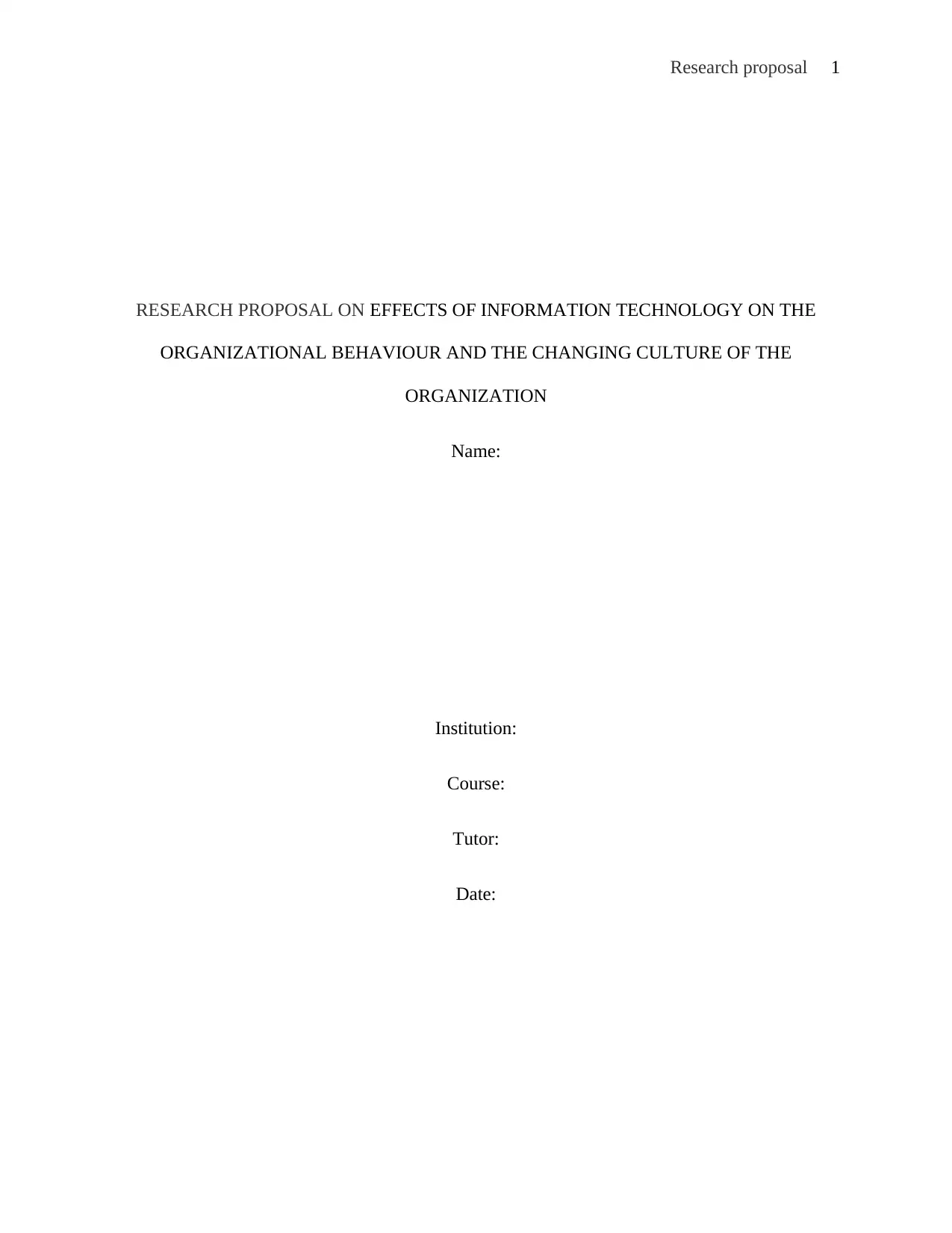
Research proposal 1
RESEARCH PROPOSAL ON EFFECTS OF INFORMATION TECHNOLOGY ON THE
ORGANIZATIONAL BEHAVIOUR AND THE CHANGING CULTURE OF THE
ORGANIZATION
Name:
Institution:
Course:
Tutor:
Date:
RESEARCH PROPOSAL ON EFFECTS OF INFORMATION TECHNOLOGY ON THE
ORGANIZATIONAL BEHAVIOUR AND THE CHANGING CULTURE OF THE
ORGANIZATION
Name:
Institution:
Course:
Tutor:
Date:
Paraphrase This Document
Need a fresh take? Get an instant paraphrase of this document with our AI Paraphraser
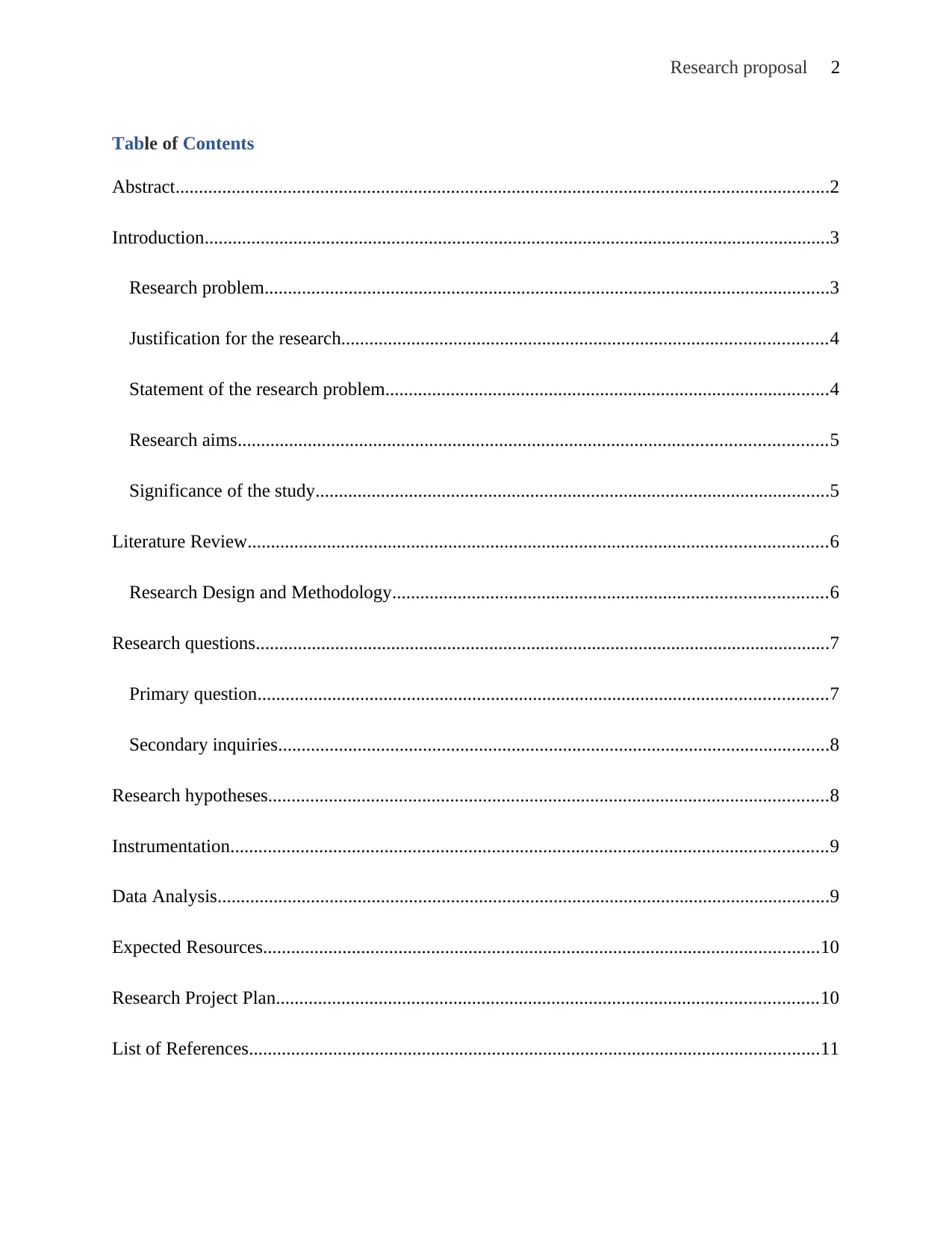
Research proposal 2
Table of Contents
Abstract............................................................................................................................................2
Introduction......................................................................................................................................3
Research problem.........................................................................................................................3
Justification for the research........................................................................................................4
Statement of the research problem...............................................................................................4
Research aims..............................................................................................................................5
Significance of the study..............................................................................................................5
Literature Review............................................................................................................................6
Research Design and Methodology.............................................................................................6
Research questions...........................................................................................................................7
Primary question..........................................................................................................................7
Secondary inquiries......................................................................................................................8
Research hypotheses........................................................................................................................8
Instrumentation................................................................................................................................9
Data Analysis...................................................................................................................................9
Expected Resources.......................................................................................................................10
Research Project Plan....................................................................................................................10
List of References..........................................................................................................................11
Table of Contents
Abstract............................................................................................................................................2
Introduction......................................................................................................................................3
Research problem.........................................................................................................................3
Justification for the research........................................................................................................4
Statement of the research problem...............................................................................................4
Research aims..............................................................................................................................5
Significance of the study..............................................................................................................5
Literature Review............................................................................................................................6
Research Design and Methodology.............................................................................................6
Research questions...........................................................................................................................7
Primary question..........................................................................................................................7
Secondary inquiries......................................................................................................................8
Research hypotheses........................................................................................................................8
Instrumentation................................................................................................................................9
Data Analysis...................................................................................................................................9
Expected Resources.......................................................................................................................10
Research Project Plan....................................................................................................................10
List of References..........................................................................................................................11
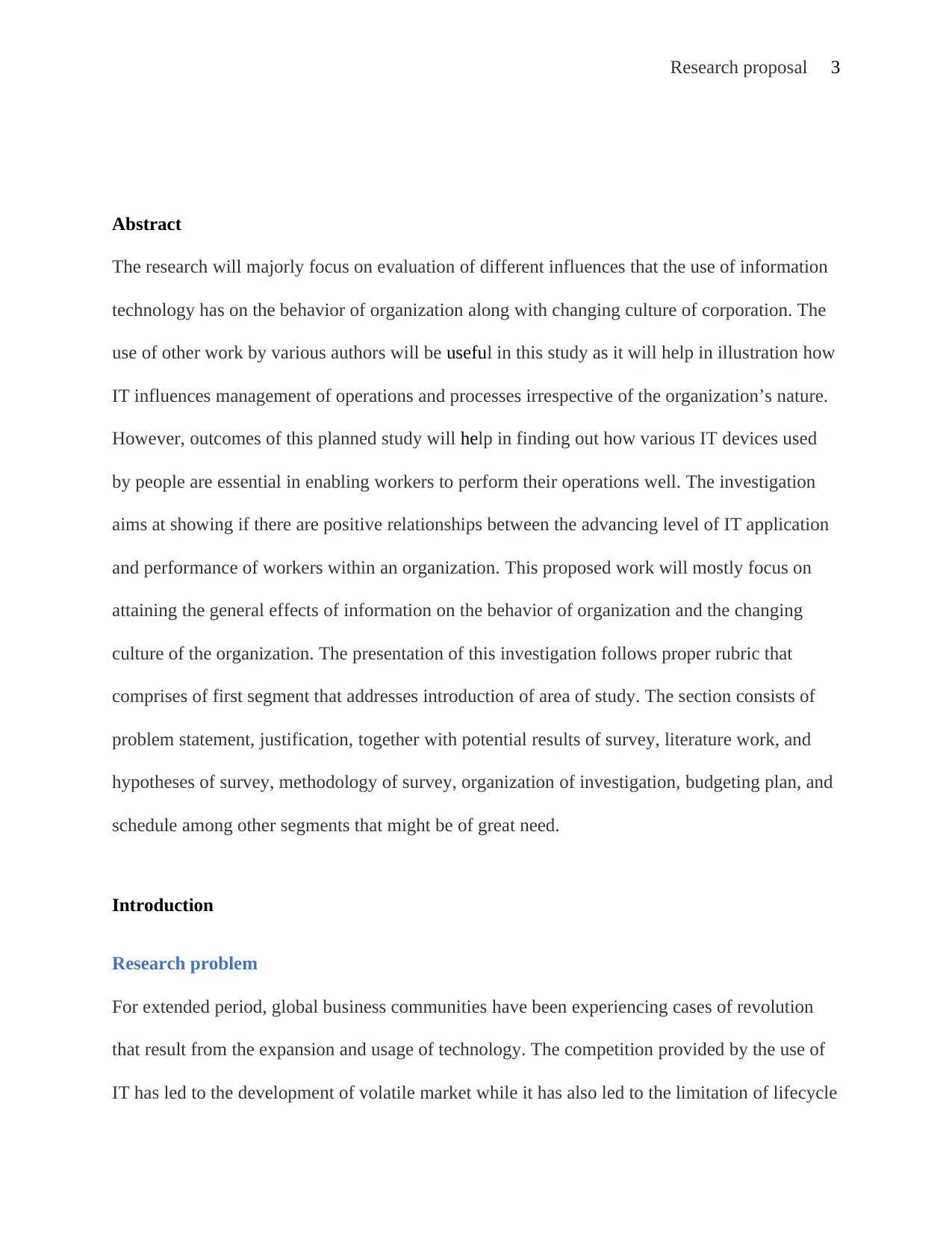
Research proposal 3
Abstract
The research will majorly focus on evaluation of different influences that the use of information
technology has on the behavior of organization along with changing culture of corporation. The
use of other work by various authors will be useful in this study as it will help in illustration how
IT influences management of operations and processes irrespective of the organization’s nature.
However, outcomes of this planned study will help in finding out how various IT devices used
by people are essential in enabling workers to perform their operations well. The investigation
aims at showing if there are positive relationships between the advancing level of IT application
and performance of workers within an organization. This proposed work will mostly focus on
attaining the general effects of information on the behavior of organization and the changing
culture of the organization. The presentation of this investigation follows proper rubric that
comprises of first segment that addresses introduction of area of study. The section consists of
problem statement, justification, together with potential results of survey, literature work, and
hypotheses of survey, methodology of survey, organization of investigation, budgeting plan, and
schedule among other segments that might be of great need.
Introduction
Research problem
For extended period, global business communities have been experiencing cases of revolution
that result from the expansion and usage of technology. The competition provided by the use of
IT has led to the development of volatile market while it has also led to the limitation of lifecycle
Abstract
The research will majorly focus on evaluation of different influences that the use of information
technology has on the behavior of organization along with changing culture of corporation. The
use of other work by various authors will be useful in this study as it will help in illustration how
IT influences management of operations and processes irrespective of the organization’s nature.
However, outcomes of this planned study will help in finding out how various IT devices used
by people are essential in enabling workers to perform their operations well. The investigation
aims at showing if there are positive relationships between the advancing level of IT application
and performance of workers within an organization. This proposed work will mostly focus on
attaining the general effects of information on the behavior of organization and the changing
culture of the organization. The presentation of this investigation follows proper rubric that
comprises of first segment that addresses introduction of area of study. The section consists of
problem statement, justification, together with potential results of survey, literature work, and
hypotheses of survey, methodology of survey, organization of investigation, budgeting plan, and
schedule among other segments that might be of great need.
Introduction
Research problem
For extended period, global business communities have been experiencing cases of revolution
that result from the expansion and usage of technology. The competition provided by the use of
IT has led to the development of volatile market while it has also led to the limitation of lifecycle
⊘ This is a preview!⊘
Do you want full access?
Subscribe today to unlock all pages.

Trusted by 1+ million students worldwide
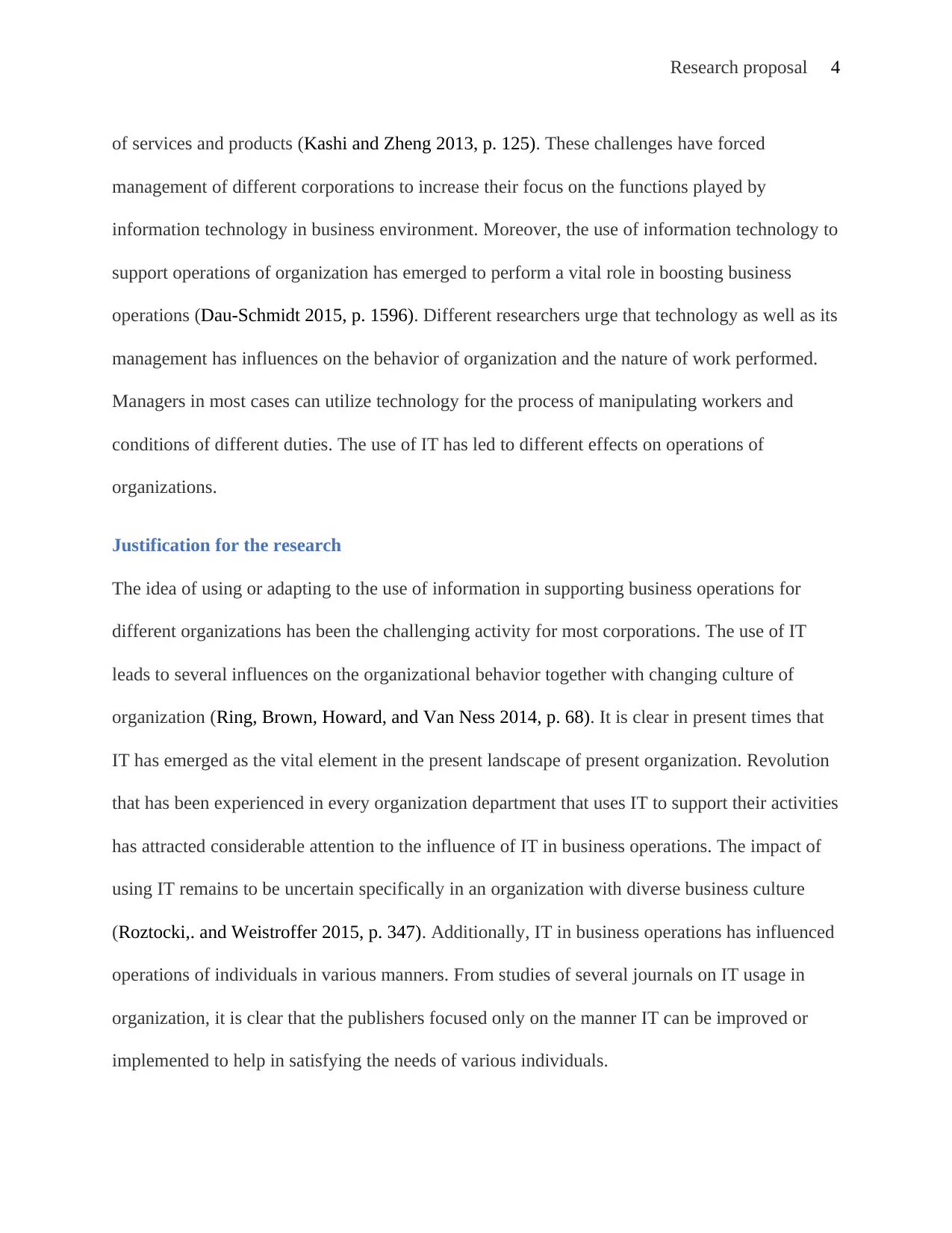
Research proposal 4
of services and products (Kashi and Zheng 2013, p. 125). These challenges have forced
management of different corporations to increase their focus on the functions played by
information technology in business environment. Moreover, the use of information technology to
support operations of organization has emerged to perform a vital role in boosting business
operations (Dau-Schmidt 2015, p. 1596). Different researchers urge that technology as well as its
management has influences on the behavior of organization and the nature of work performed.
Managers in most cases can utilize technology for the process of manipulating workers and
conditions of different duties. The use of IT has led to different effects on operations of
organizations.
Justification for the research
The idea of using or adapting to the use of information in supporting business operations for
different organizations has been the challenging activity for most corporations. The use of IT
leads to several influences on the organizational behavior together with changing culture of
organization (Ring, Brown, Howard, and Van Ness 2014, p. 68). It is clear in present times that
IT has emerged as the vital element in the present landscape of present organization. Revolution
that has been experienced in every organization department that uses IT to support their activities
has attracted considerable attention to the influence of IT in business operations. The impact of
using IT remains to be uncertain specifically in an organization with diverse business culture
(Roztocki,. and Weistroffer 2015, p. 347). Additionally, IT in business operations has influenced
operations of individuals in various manners. From studies of several journals on IT usage in
organization, it is clear that the publishers focused only on the manner IT can be improved or
implemented to help in satisfying the needs of various individuals.
of services and products (Kashi and Zheng 2013, p. 125). These challenges have forced
management of different corporations to increase their focus on the functions played by
information technology in business environment. Moreover, the use of information technology to
support operations of organization has emerged to perform a vital role in boosting business
operations (Dau-Schmidt 2015, p. 1596). Different researchers urge that technology as well as its
management has influences on the behavior of organization and the nature of work performed.
Managers in most cases can utilize technology for the process of manipulating workers and
conditions of different duties. The use of IT has led to different effects on operations of
organizations.
Justification for the research
The idea of using or adapting to the use of information in supporting business operations for
different organizations has been the challenging activity for most corporations. The use of IT
leads to several influences on the organizational behavior together with changing culture of
organization (Ring, Brown, Howard, and Van Ness 2014, p. 68). It is clear in present times that
IT has emerged as the vital element in the present landscape of present organization. Revolution
that has been experienced in every organization department that uses IT to support their activities
has attracted considerable attention to the influence of IT in business operations. The impact of
using IT remains to be uncertain specifically in an organization with diverse business culture
(Roztocki,. and Weistroffer 2015, p. 347). Additionally, IT in business operations has influenced
operations of individuals in various manners. From studies of several journals on IT usage in
organization, it is clear that the publishers focused only on the manner IT can be improved or
implemented to help in satisfying the needs of various individuals.
Paraphrase This Document
Need a fresh take? Get an instant paraphrase of this document with our AI Paraphraser
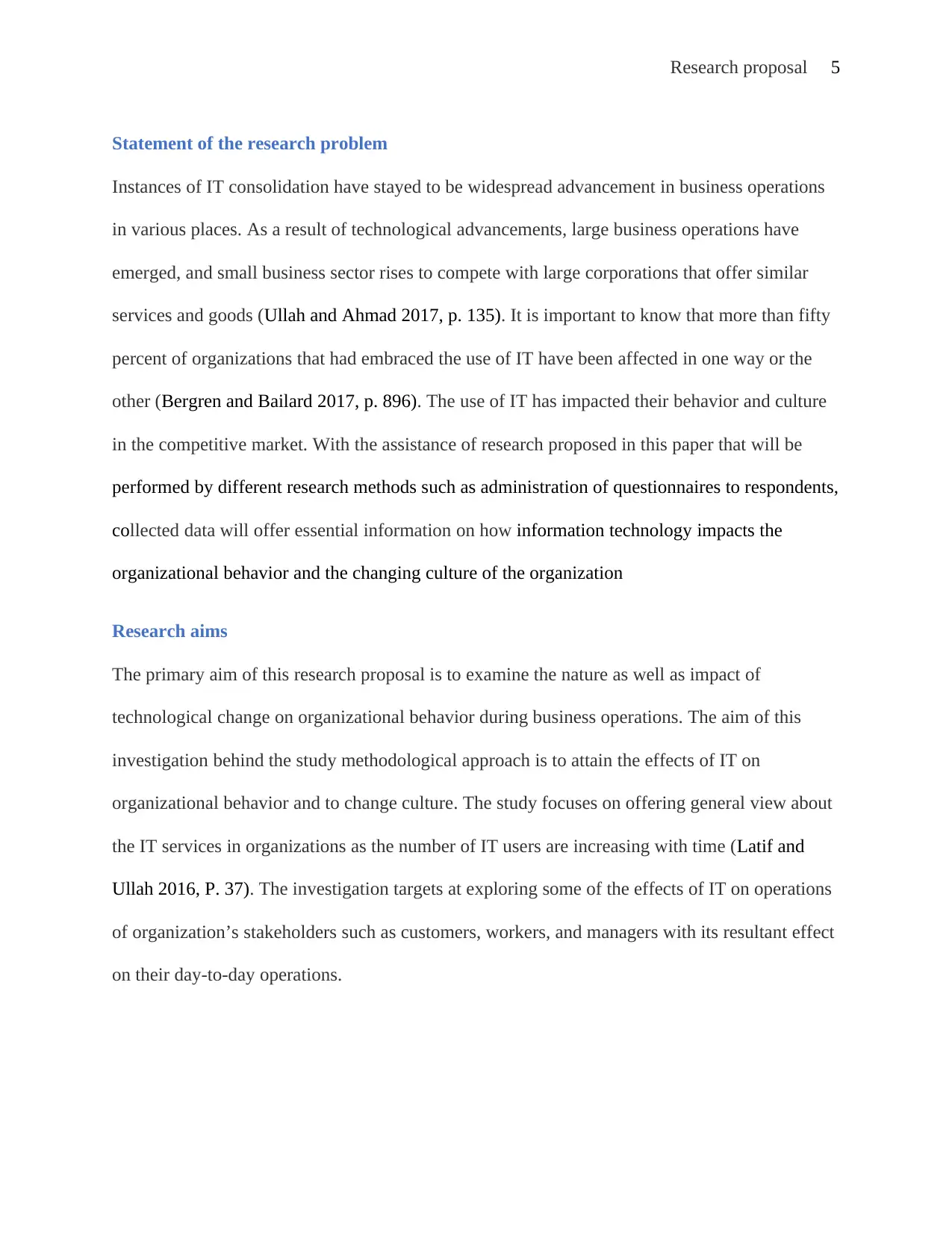
Research proposal 5
Statement of the research problem
Instances of IT consolidation have stayed to be widespread advancement in business operations
in various places. As a result of technological advancements, large business operations have
emerged, and small business sector rises to compete with large corporations that offer similar
services and goods (Ullah and Ahmad 2017, p. 135). It is important to know that more than fifty
percent of organizations that had embraced the use of IT have been affected in one way or the
other (Bergren and Bailard 2017, p. 896). The use of IT has impacted their behavior and culture
in the competitive market. With the assistance of research proposed in this paper that will be
performed by different research methods such as administration of questionnaires to respondents,
collected data will offer essential information on how information technology impacts the
organizational behavior and the changing culture of the organization
Research aims
The primary aim of this research proposal is to examine the nature as well as impact of
technological change on organizational behavior during business operations. The aim of this
investigation behind the study methodological approach is to attain the effects of IT on
organizational behavior and to change culture. The study focuses on offering general view about
the IT services in organizations as the number of IT users are increasing with time (Latif and
Ullah 2016, P. 37). The investigation targets at exploring some of the effects of IT on operations
of organization’s stakeholders such as customers, workers, and managers with its resultant effect
on their day-to-day operations.
Statement of the research problem
Instances of IT consolidation have stayed to be widespread advancement in business operations
in various places. As a result of technological advancements, large business operations have
emerged, and small business sector rises to compete with large corporations that offer similar
services and goods (Ullah and Ahmad 2017, p. 135). It is important to know that more than fifty
percent of organizations that had embraced the use of IT have been affected in one way or the
other (Bergren and Bailard 2017, p. 896). The use of IT has impacted their behavior and culture
in the competitive market. With the assistance of research proposed in this paper that will be
performed by different research methods such as administration of questionnaires to respondents,
collected data will offer essential information on how information technology impacts the
organizational behavior and the changing culture of the organization
Research aims
The primary aim of this research proposal is to examine the nature as well as impact of
technological change on organizational behavior during business operations. The aim of this
investigation behind the study methodological approach is to attain the effects of IT on
organizational behavior and to change culture. The study focuses on offering general view about
the IT services in organizations as the number of IT users are increasing with time (Latif and
Ullah 2016, P. 37). The investigation targets at exploring some of the effects of IT on operations
of organization’s stakeholders such as customers, workers, and managers with its resultant effect
on their day-to-day operations.
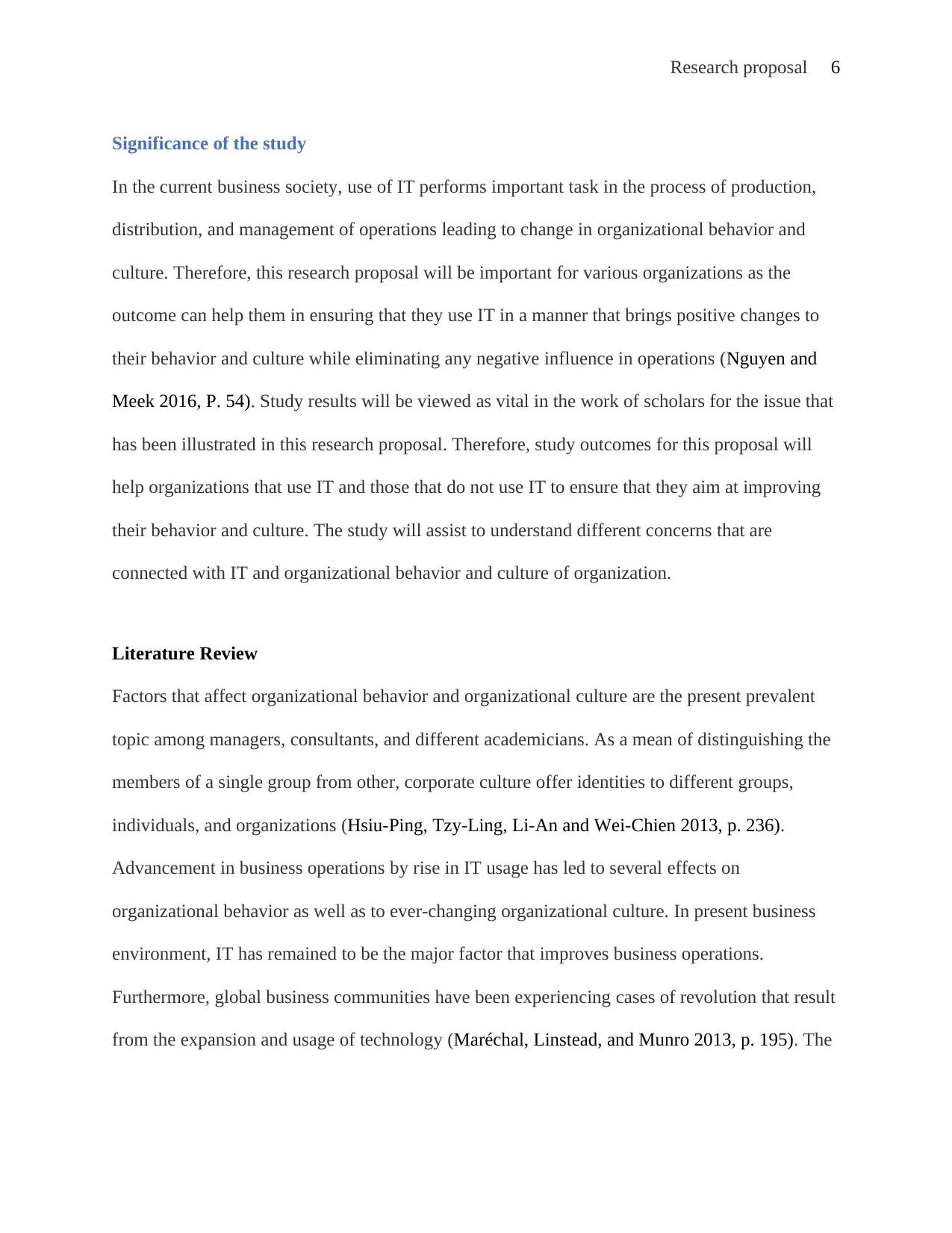
Research proposal 6
Significance of the study
In the current business society, use of IT performs important task in the process of production,
distribution, and management of operations leading to change in organizational behavior and
culture. Therefore, this research proposal will be important for various organizations as the
outcome can help them in ensuring that they use IT in a manner that brings positive changes to
their behavior and culture while eliminating any negative influence in operations (Nguyen and
Meek 2016, P. 54). Study results will be viewed as vital in the work of scholars for the issue that
has been illustrated in this research proposal. Therefore, study outcomes for this proposal will
help organizations that use IT and those that do not use IT to ensure that they aim at improving
their behavior and culture. The study will assist to understand different concerns that are
connected with IT and organizational behavior and culture of organization.
Literature Review
Factors that affect organizational behavior and organizational culture are the present prevalent
topic among managers, consultants, and different academicians. As a mean of distinguishing the
members of a single group from other, corporate culture offer identities to different groups,
individuals, and organizations (Hsiu-Ping, Tzy-Ling, Li-An and Wei-Chien 2013, p. 236).
Advancement in business operations by rise in IT usage has led to several effects on
organizational behavior as well as to ever-changing organizational culture. In present business
environment, IT has remained to be the major factor that improves business operations.
Furthermore, global business communities have been experiencing cases of revolution that result
from the expansion and usage of technology (Maréchal, Linstead, and Munro 2013, p. 195). The
Significance of the study
In the current business society, use of IT performs important task in the process of production,
distribution, and management of operations leading to change in organizational behavior and
culture. Therefore, this research proposal will be important for various organizations as the
outcome can help them in ensuring that they use IT in a manner that brings positive changes to
their behavior and culture while eliminating any negative influence in operations (Nguyen and
Meek 2016, P. 54). Study results will be viewed as vital in the work of scholars for the issue that
has been illustrated in this research proposal. Therefore, study outcomes for this proposal will
help organizations that use IT and those that do not use IT to ensure that they aim at improving
their behavior and culture. The study will assist to understand different concerns that are
connected with IT and organizational behavior and culture of organization.
Literature Review
Factors that affect organizational behavior and organizational culture are the present prevalent
topic among managers, consultants, and different academicians. As a mean of distinguishing the
members of a single group from other, corporate culture offer identities to different groups,
individuals, and organizations (Hsiu-Ping, Tzy-Ling, Li-An and Wei-Chien 2013, p. 236).
Advancement in business operations by rise in IT usage has led to several effects on
organizational behavior as well as to ever-changing organizational culture. In present business
environment, IT has remained to be the major factor that improves business operations.
Furthermore, global business communities have been experiencing cases of revolution that result
from the expansion and usage of technology (Maréchal, Linstead, and Munro 2013, p. 195). The
⊘ This is a preview!⊘
Do you want full access?
Subscribe today to unlock all pages.

Trusted by 1+ million students worldwide
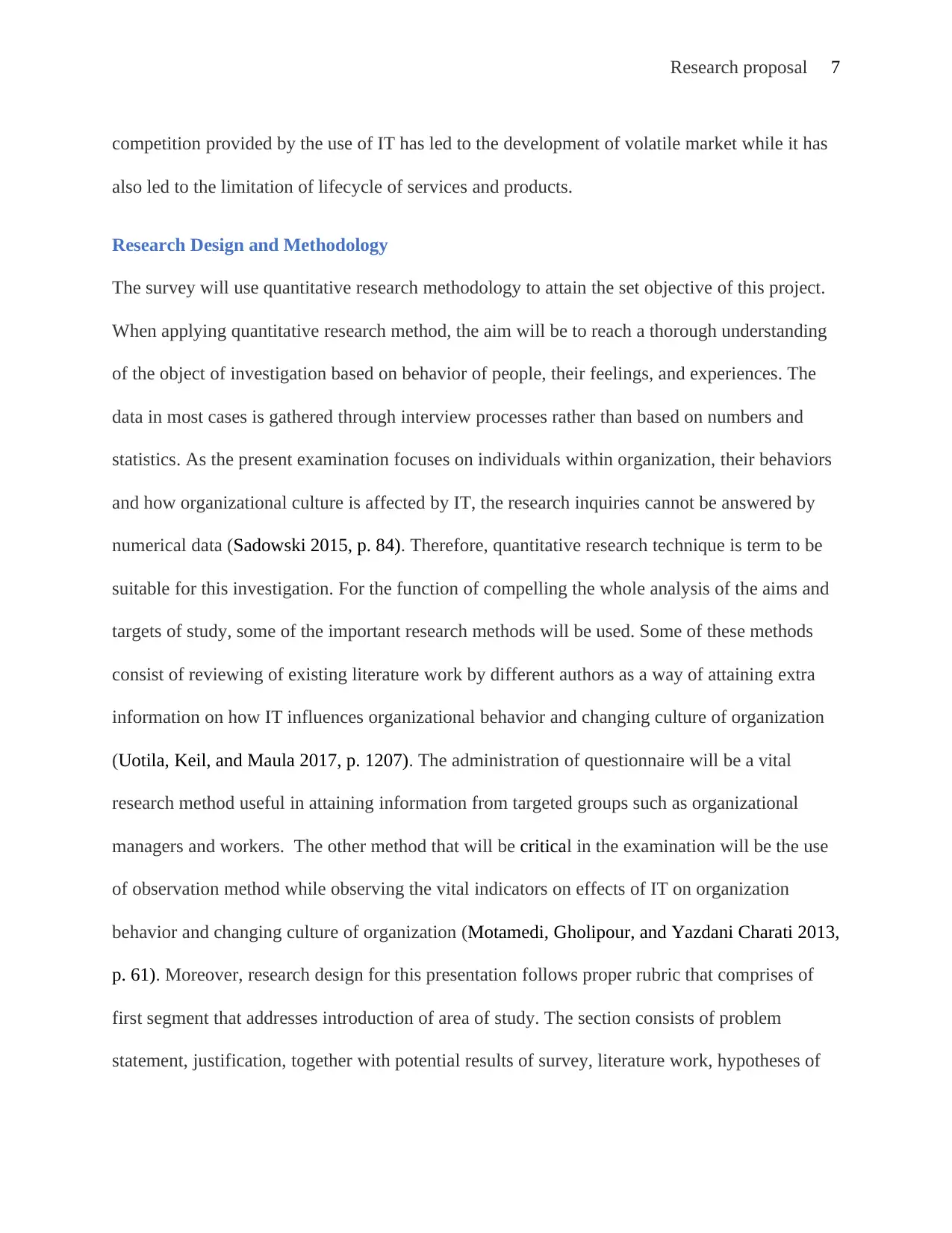
Research proposal 7
competition provided by the use of IT has led to the development of volatile market while it has
also led to the limitation of lifecycle of services and products.
Research Design and Methodology
The survey will use quantitative research methodology to attain the set objective of this project.
When applying quantitative research method, the aim will be to reach a thorough understanding
of the object of investigation based on behavior of people, their feelings, and experiences. The
data in most cases is gathered through interview processes rather than based on numbers and
statistics. As the present examination focuses on individuals within organization, their behaviors
and how organizational culture is affected by IT, the research inquiries cannot be answered by
numerical data (Sadowski 2015, p. 84). Therefore, quantitative research technique is term to be
suitable for this investigation. For the function of compelling the whole analysis of the aims and
targets of study, some of the important research methods will be used. Some of these methods
consist of reviewing of existing literature work by different authors as a way of attaining extra
information on how IT influences organizational behavior and changing culture of organization
(Uotila, Keil, and Maula 2017, p. 1207). The administration of questionnaire will be a vital
research method useful in attaining information from targeted groups such as organizational
managers and workers. The other method that will be critical in the examination will be the use
of observation method while observing the vital indicators on effects of IT on organization
behavior and changing culture of organization (Motamedi, Gholipour, and Yazdani Charati 2013,
p. 61). Moreover, research design for this presentation follows proper rubric that comprises of
first segment that addresses introduction of area of study. The section consists of problem
statement, justification, together with potential results of survey, literature work, hypotheses of
competition provided by the use of IT has led to the development of volatile market while it has
also led to the limitation of lifecycle of services and products.
Research Design and Methodology
The survey will use quantitative research methodology to attain the set objective of this project.
When applying quantitative research method, the aim will be to reach a thorough understanding
of the object of investigation based on behavior of people, their feelings, and experiences. The
data in most cases is gathered through interview processes rather than based on numbers and
statistics. As the present examination focuses on individuals within organization, their behaviors
and how organizational culture is affected by IT, the research inquiries cannot be answered by
numerical data (Sadowski 2015, p. 84). Therefore, quantitative research technique is term to be
suitable for this investigation. For the function of compelling the whole analysis of the aims and
targets of study, some of the important research methods will be used. Some of these methods
consist of reviewing of existing literature work by different authors as a way of attaining extra
information on how IT influences organizational behavior and changing culture of organization
(Uotila, Keil, and Maula 2017, p. 1207). The administration of questionnaire will be a vital
research method useful in attaining information from targeted groups such as organizational
managers and workers. The other method that will be critical in the examination will be the use
of observation method while observing the vital indicators on effects of IT on organization
behavior and changing culture of organization (Motamedi, Gholipour, and Yazdani Charati 2013,
p. 61). Moreover, research design for this presentation follows proper rubric that comprises of
first segment that addresses introduction of area of study. The section consists of problem
statement, justification, together with potential results of survey, literature work, hypotheses of
Paraphrase This Document
Need a fresh take? Get an instant paraphrase of this document with our AI Paraphraser
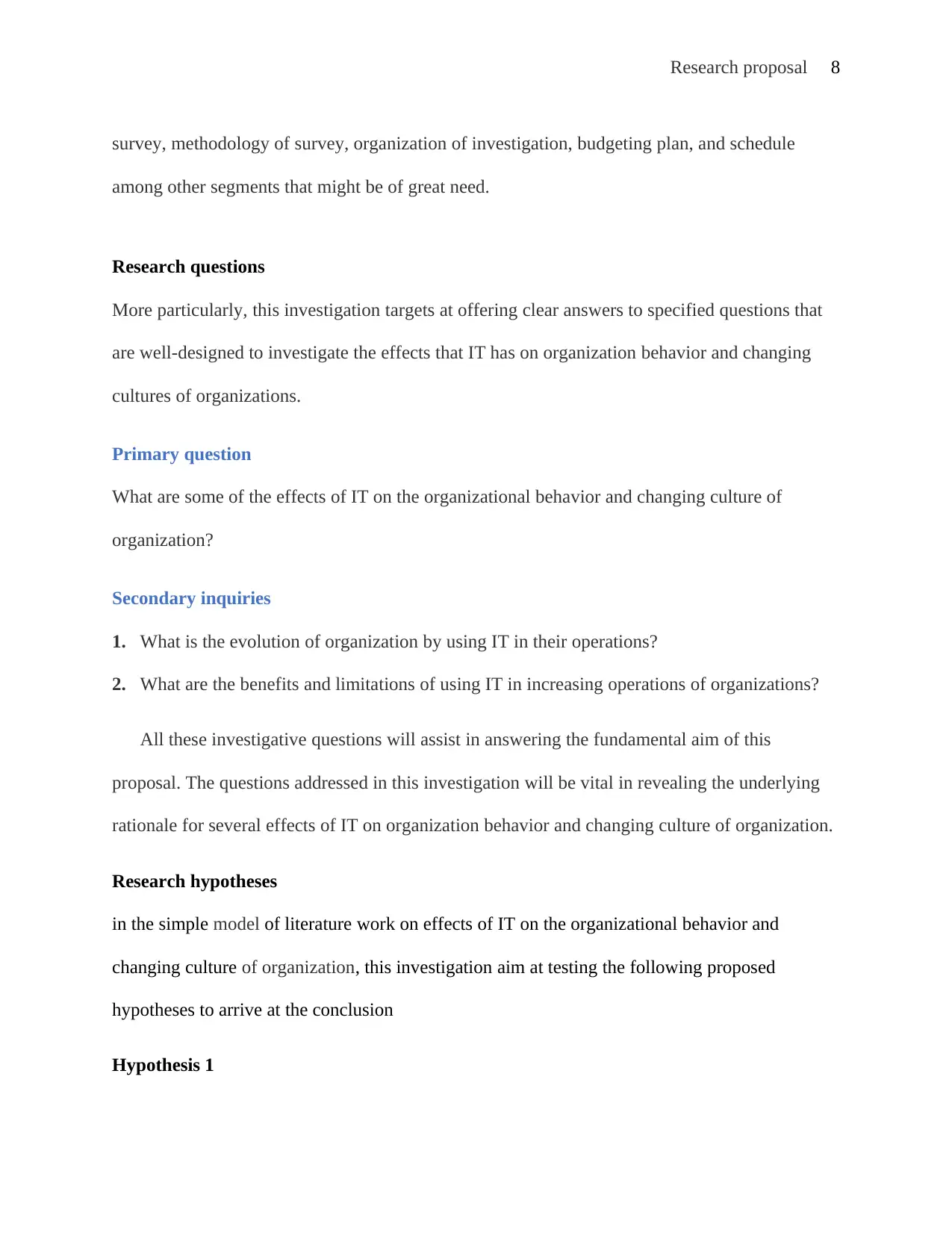
Research proposal 8
survey, methodology of survey, organization of investigation, budgeting plan, and schedule
among other segments that might be of great need.
Research questions
More particularly, this investigation targets at offering clear answers to specified questions that
are well-designed to investigate the effects that IT has on organization behavior and changing
cultures of organizations.
Primary question
What are some of the effects of IT on the organizational behavior and changing culture of
organization?
Secondary inquiries
1. What is the evolution of organization by using IT in their operations?
2. What are the benefits and limitations of using IT in increasing operations of organizations?
All these investigative questions will assist in answering the fundamental aim of this
proposal. The questions addressed in this investigation will be vital in revealing the underlying
rationale for several effects of IT on organization behavior and changing culture of organization.
Research hypotheses
in the simple model of literature work on effects of IT on the organizational behavior and
changing culture of organization, this investigation aim at testing the following proposed
hypotheses to arrive at the conclusion
Hypothesis 1
survey, methodology of survey, organization of investigation, budgeting plan, and schedule
among other segments that might be of great need.
Research questions
More particularly, this investigation targets at offering clear answers to specified questions that
are well-designed to investigate the effects that IT has on organization behavior and changing
cultures of organizations.
Primary question
What are some of the effects of IT on the organizational behavior and changing culture of
organization?
Secondary inquiries
1. What is the evolution of organization by using IT in their operations?
2. What are the benefits and limitations of using IT in increasing operations of organizations?
All these investigative questions will assist in answering the fundamental aim of this
proposal. The questions addressed in this investigation will be vital in revealing the underlying
rationale for several effects of IT on organization behavior and changing culture of organization.
Research hypotheses
in the simple model of literature work on effects of IT on the organizational behavior and
changing culture of organization, this investigation aim at testing the following proposed
hypotheses to arrive at the conclusion
Hypothesis 1
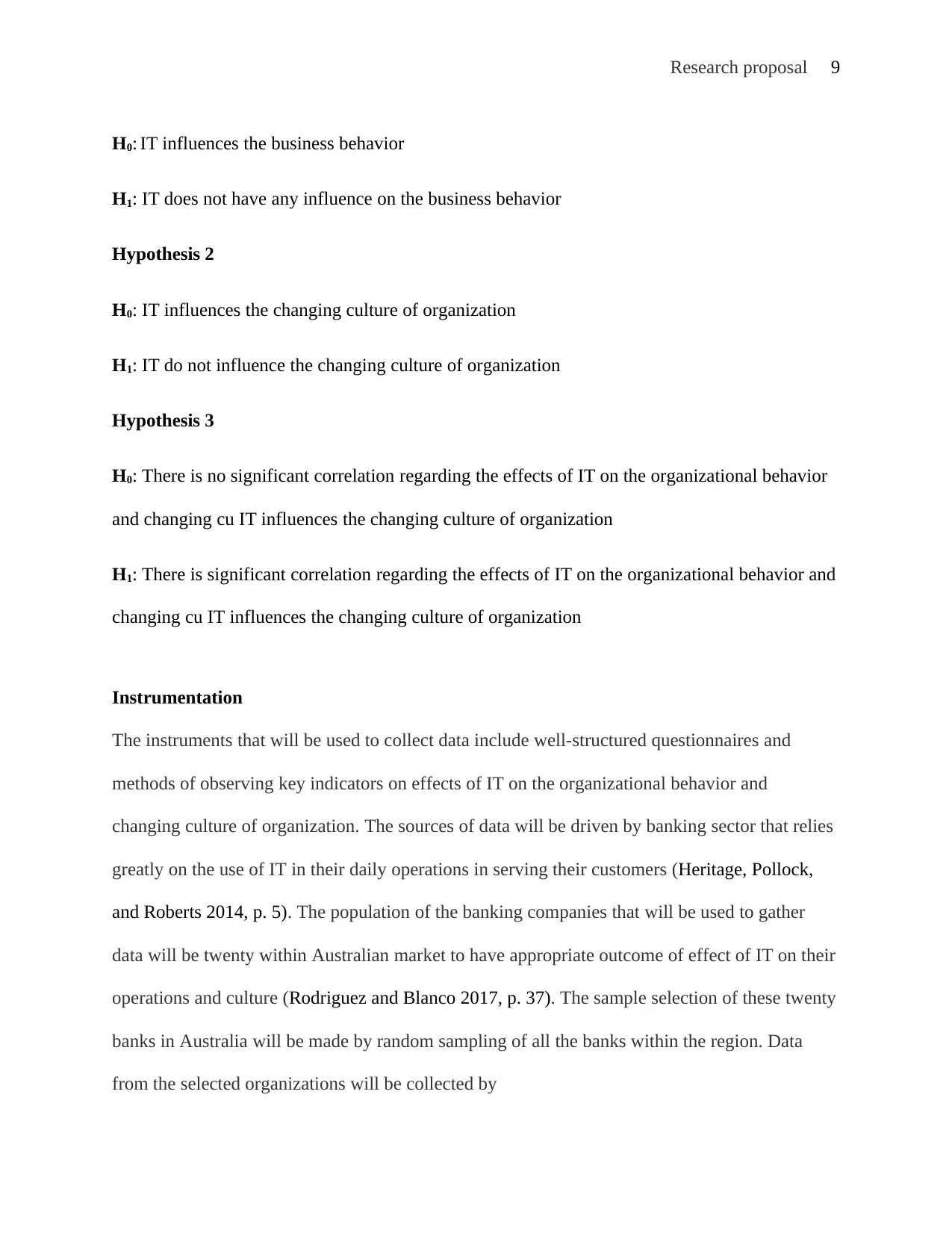
Research proposal 9
H0: IT influences the business behavior
H1: IT does not have any influence on the business behavior
Hypothesis 2
H0: IT influences the changing culture of organization
H1: IT do not influence the changing culture of organization
Hypothesis 3
H0: There is no significant correlation regarding the effects of IT on the organizational behavior
and changing cu IT influences the changing culture of organization
H1: There is significant correlation regarding the effects of IT on the organizational behavior and
changing cu IT influences the changing culture of organization
Instrumentation
The instruments that will be used to collect data include well-structured questionnaires and
methods of observing key indicators on effects of IT on the organizational behavior and
changing culture of organization. The sources of data will be driven by banking sector that relies
greatly on the use of IT in their daily operations in serving their customers (Heritage, Pollock,
and Roberts 2014, p. 5). The population of the banking companies that will be used to gather
data will be twenty within Australian market to have appropriate outcome of effect of IT on their
operations and culture (Rodriguez and Blanco 2017, p. 37). The sample selection of these twenty
banks in Australia will be made by random sampling of all the banks within the region. Data
from the selected organizations will be collected by
H0: IT influences the business behavior
H1: IT does not have any influence on the business behavior
Hypothesis 2
H0: IT influences the changing culture of organization
H1: IT do not influence the changing culture of organization
Hypothesis 3
H0: There is no significant correlation regarding the effects of IT on the organizational behavior
and changing cu IT influences the changing culture of organization
H1: There is significant correlation regarding the effects of IT on the organizational behavior and
changing cu IT influences the changing culture of organization
Instrumentation
The instruments that will be used to collect data include well-structured questionnaires and
methods of observing key indicators on effects of IT on the organizational behavior and
changing culture of organization. The sources of data will be driven by banking sector that relies
greatly on the use of IT in their daily operations in serving their customers (Heritage, Pollock,
and Roberts 2014, p. 5). The population of the banking companies that will be used to gather
data will be twenty within Australian market to have appropriate outcome of effect of IT on their
operations and culture (Rodriguez and Blanco 2017, p. 37). The sample selection of these twenty
banks in Australia will be made by random sampling of all the banks within the region. Data
from the selected organizations will be collected by
⊘ This is a preview!⊘
Do you want full access?
Subscribe today to unlock all pages.

Trusted by 1+ million students worldwide
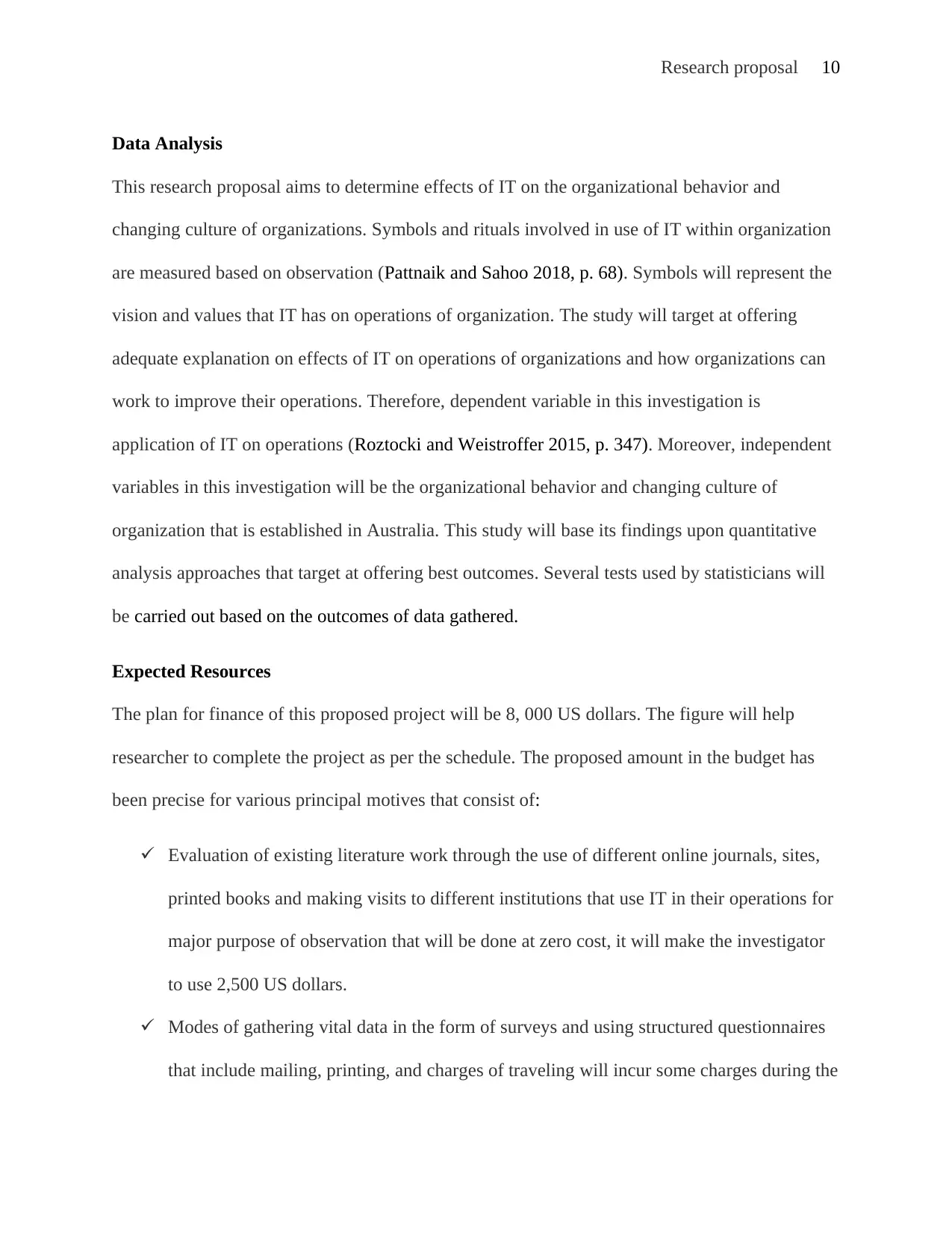
Research proposal 10
Data Analysis
This research proposal aims to determine effects of IT on the organizational behavior and
changing culture of organizations. Symbols and rituals involved in use of IT within organization
are measured based on observation (Pattnaik and Sahoo 2018, p. 68). Symbols will represent the
vision and values that IT has on operations of organization. The study will target at offering
adequate explanation on effects of IT on operations of organizations and how organizations can
work to improve their operations. Therefore, dependent variable in this investigation is
application of IT on operations (Roztocki and Weistroffer 2015, p. 347). Moreover, independent
variables in this investigation will be the organizational behavior and changing culture of
organization that is established in Australia. This study will base its findings upon quantitative
analysis approaches that target at offering best outcomes. Several tests used by statisticians will
be carried out based on the outcomes of data gathered.
Expected Resources
The plan for finance of this proposed project will be 8, 000 US dollars. The figure will help
researcher to complete the project as per the schedule. The proposed amount in the budget has
been precise for various principal motives that consist of:
Evaluation of existing literature work through the use of different online journals, sites,
printed books and making visits to different institutions that use IT in their operations for
major purpose of observation that will be done at zero cost, it will make the investigator
to use 2,500 US dollars.
Modes of gathering vital data in the form of surveys and using structured questionnaires
that include mailing, printing, and charges of traveling will incur some charges during the
Data Analysis
This research proposal aims to determine effects of IT on the organizational behavior and
changing culture of organizations. Symbols and rituals involved in use of IT within organization
are measured based on observation (Pattnaik and Sahoo 2018, p. 68). Symbols will represent the
vision and values that IT has on operations of organization. The study will target at offering
adequate explanation on effects of IT on operations of organizations and how organizations can
work to improve their operations. Therefore, dependent variable in this investigation is
application of IT on operations (Roztocki and Weistroffer 2015, p. 347). Moreover, independent
variables in this investigation will be the organizational behavior and changing culture of
organization that is established in Australia. This study will base its findings upon quantitative
analysis approaches that target at offering best outcomes. Several tests used by statisticians will
be carried out based on the outcomes of data gathered.
Expected Resources
The plan for finance of this proposed project will be 8, 000 US dollars. The figure will help
researcher to complete the project as per the schedule. The proposed amount in the budget has
been precise for various principal motives that consist of:
Evaluation of existing literature work through the use of different online journals, sites,
printed books and making visits to different institutions that use IT in their operations for
major purpose of observation that will be done at zero cost, it will make the investigator
to use 2,500 US dollars.
Modes of gathering vital data in the form of surveys and using structured questionnaires
that include mailing, printing, and charges of traveling will incur some charges during the
Paraphrase This Document
Need a fresh take? Get an instant paraphrase of this document with our AI Paraphraser
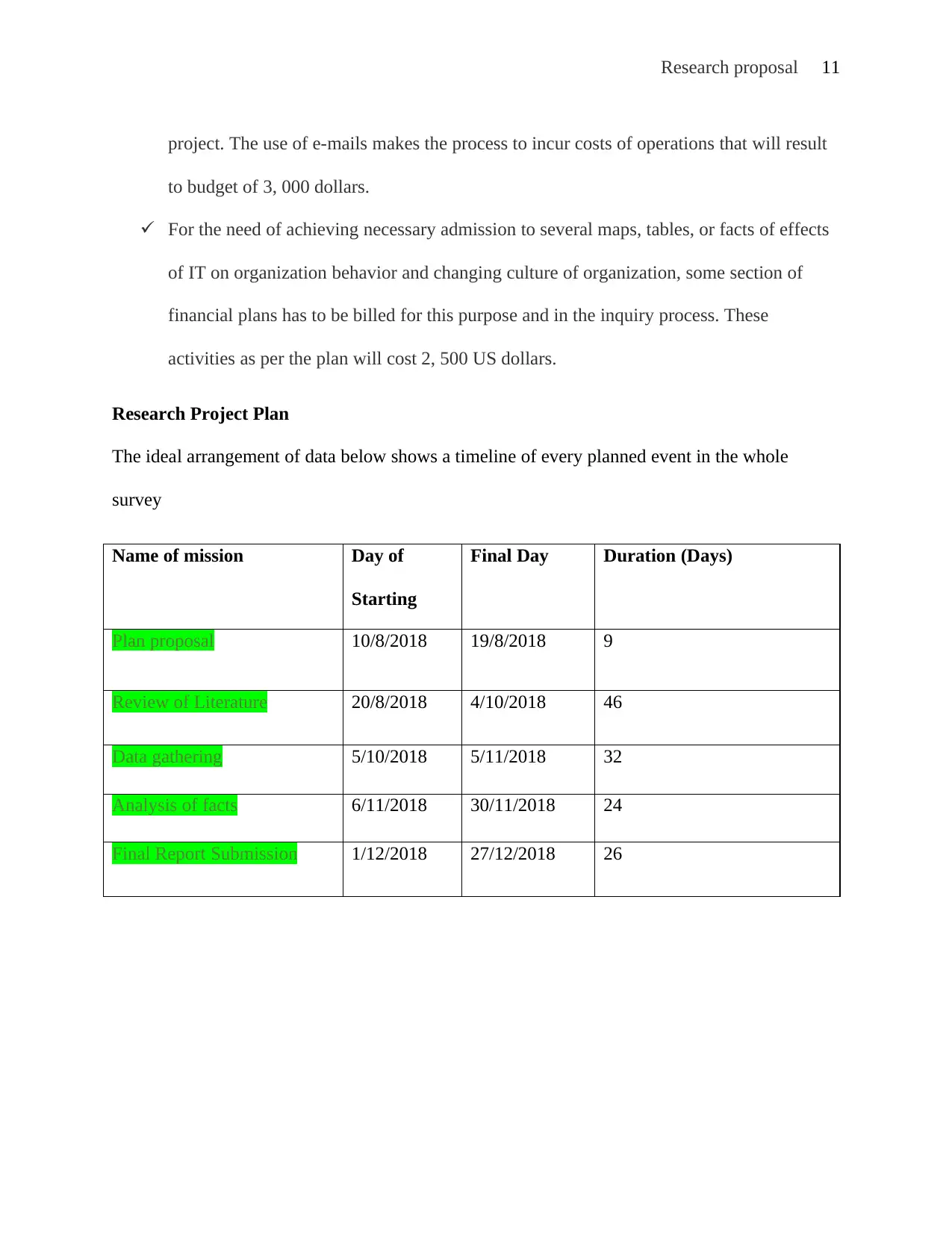
Research proposal 11
project. The use of e-mails makes the process to incur costs of operations that will result
to budget of 3, 000 dollars.
For the need of achieving necessary admission to several maps, tables, or facts of effects
of IT on organization behavior and changing culture of organization, some section of
financial plans has to be billed for this purpose and in the inquiry process. These
activities as per the plan will cost 2, 500 US dollars.
Research Project Plan
The ideal arrangement of data below shows a timeline of every planned event in the whole
survey
Name of mission Day of
Starting
Final Day Duration (Days)
Plan proposal 10/8/2018 19/8/2018 9
Review of Literature 20/8/2018 4/10/2018 46
Data gathering 5/10/2018 5/11/2018 32
Analysis of facts 6/11/2018 30/11/2018 24
Final Report Submission 1/12/2018 27/12/2018 26
project. The use of e-mails makes the process to incur costs of operations that will result
to budget of 3, 000 dollars.
For the need of achieving necessary admission to several maps, tables, or facts of effects
of IT on organization behavior and changing culture of organization, some section of
financial plans has to be billed for this purpose and in the inquiry process. These
activities as per the plan will cost 2, 500 US dollars.
Research Project Plan
The ideal arrangement of data below shows a timeline of every planned event in the whole
survey
Name of mission Day of
Starting
Final Day Duration (Days)
Plan proposal 10/8/2018 19/8/2018 9
Review of Literature 20/8/2018 4/10/2018 46
Data gathering 5/10/2018 5/11/2018 32
Analysis of facts 6/11/2018 30/11/2018 24
Final Report Submission 1/12/2018 27/12/2018 26
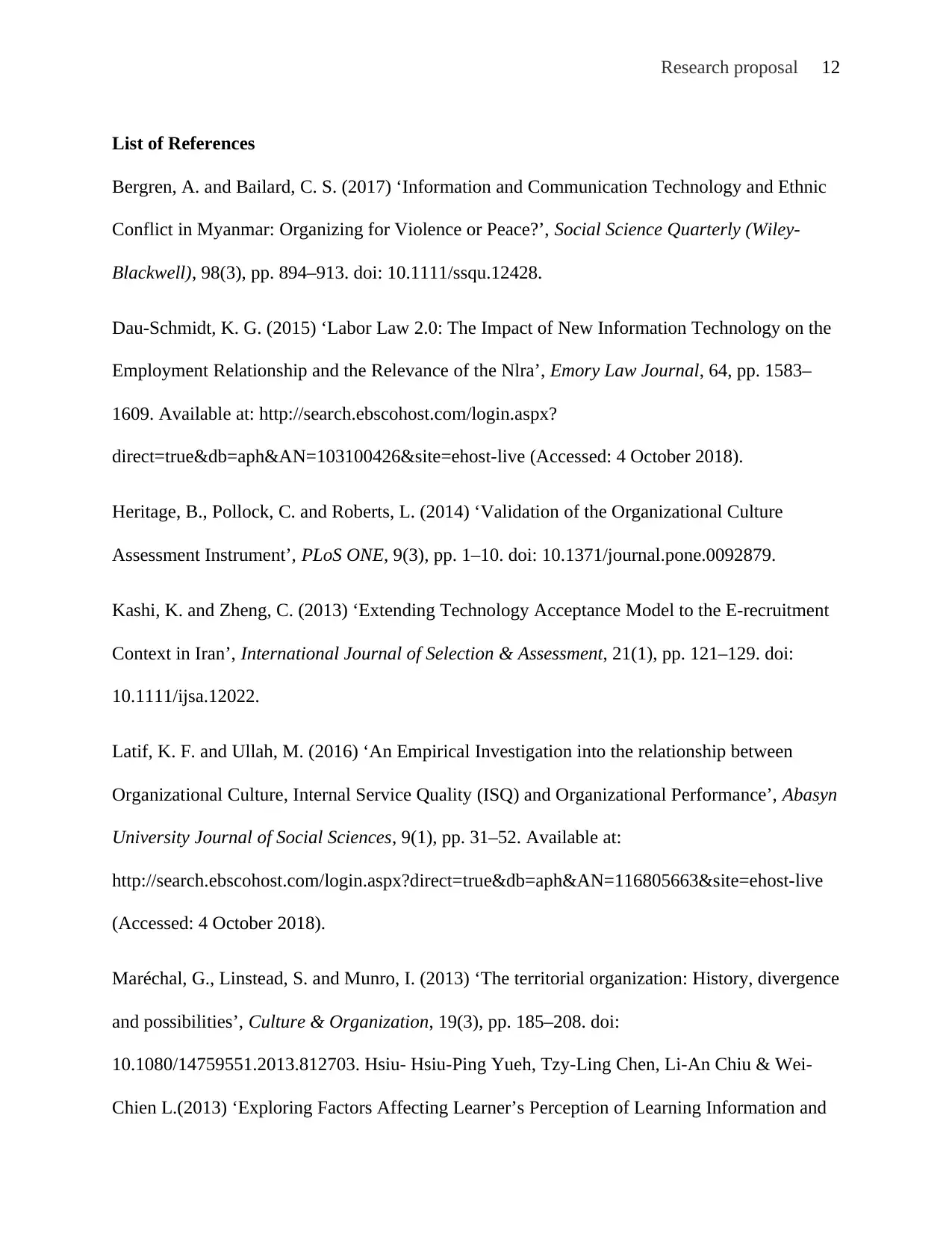
Research proposal 12
List of References
Bergren, A. and Bailard, C. S. (2017) ‘Information and Communication Technology and Ethnic
Conflict in Myanmar: Organizing for Violence or Peace?’, Social Science Quarterly (Wiley-
Blackwell), 98(3), pp. 894–913. doi: 10.1111/ssqu.12428.
Dau-Schmidt, K. G. (2015) ‘Labor Law 2.0: The Impact of New Information Technology on the
Employment Relationship and the Relevance of the Nlra’, Emory Law Journal, 64, pp. 1583–
1609. Available at: http://search.ebscohost.com/login.aspx?
direct=true&db=aph&AN=103100426&site=ehost-live (Accessed: 4 October 2018).
Heritage, B., Pollock, C. and Roberts, L. (2014) ‘Validation of the Organizational Culture
Assessment Instrument’, PLoS ONE, 9(3), pp. 1–10. doi: 10.1371/journal.pone.0092879.
Kashi, K. and Zheng, C. (2013) ‘Extending Technology Acceptance Model to the E-recruitment
Context in Iran’, International Journal of Selection & Assessment, 21(1), pp. 121–129. doi:
10.1111/ijsa.12022.
Latif, K. F. and Ullah, M. (2016) ‘An Empirical Investigation into the relationship between
Organizational Culture, Internal Service Quality (ISQ) and Organizational Performance’, Abasyn
University Journal of Social Sciences, 9(1), pp. 31–52. Available at:
http://search.ebscohost.com/login.aspx?direct=true&db=aph&AN=116805663&site=ehost-live
(Accessed: 4 October 2018).
Maréchal, G., Linstead, S. and Munro, I. (2013) ‘The territorial organization: History, divergence
and possibilities’, Culture & Organization, 19(3), pp. 185–208. doi:
10.1080/14759551.2013.812703. Hsiu- Hsiu-Ping Yueh, Tzy-Ling Chen, Li-An Chiu & Wei-
Chien L.(2013) ‘Exploring Factors Affecting Learner’s Perception of Learning Information and
List of References
Bergren, A. and Bailard, C. S. (2017) ‘Information and Communication Technology and Ethnic
Conflict in Myanmar: Organizing for Violence or Peace?’, Social Science Quarterly (Wiley-
Blackwell), 98(3), pp. 894–913. doi: 10.1111/ssqu.12428.
Dau-Schmidt, K. G. (2015) ‘Labor Law 2.0: The Impact of New Information Technology on the
Employment Relationship and the Relevance of the Nlra’, Emory Law Journal, 64, pp. 1583–
1609. Available at: http://search.ebscohost.com/login.aspx?
direct=true&db=aph&AN=103100426&site=ehost-live (Accessed: 4 October 2018).
Heritage, B., Pollock, C. and Roberts, L. (2014) ‘Validation of the Organizational Culture
Assessment Instrument’, PLoS ONE, 9(3), pp. 1–10. doi: 10.1371/journal.pone.0092879.
Kashi, K. and Zheng, C. (2013) ‘Extending Technology Acceptance Model to the E-recruitment
Context in Iran’, International Journal of Selection & Assessment, 21(1), pp. 121–129. doi:
10.1111/ijsa.12022.
Latif, K. F. and Ullah, M. (2016) ‘An Empirical Investigation into the relationship between
Organizational Culture, Internal Service Quality (ISQ) and Organizational Performance’, Abasyn
University Journal of Social Sciences, 9(1), pp. 31–52. Available at:
http://search.ebscohost.com/login.aspx?direct=true&db=aph&AN=116805663&site=ehost-live
(Accessed: 4 October 2018).
Maréchal, G., Linstead, S. and Munro, I. (2013) ‘The territorial organization: History, divergence
and possibilities’, Culture & Organization, 19(3), pp. 185–208. doi:
10.1080/14759551.2013.812703. Hsiu- Hsiu-Ping Yueh, Tzy-Ling Chen, Li-An Chiu & Wei-
Chien L.(2013) ‘Exploring Factors Affecting Learner’s Perception of Learning Information and
⊘ This is a preview!⊘
Do you want full access?
Subscribe today to unlock all pages.

Trusted by 1+ million students worldwide
1 out of 14
Related Documents
Your All-in-One AI-Powered Toolkit for Academic Success.
+13062052269
info@desklib.com
Available 24*7 on WhatsApp / Email
![[object Object]](/_next/static/media/star-bottom.7253800d.svg)
Unlock your academic potential
Copyright © 2020–2025 A2Z Services. All Rights Reserved. Developed and managed by ZUCOL.





